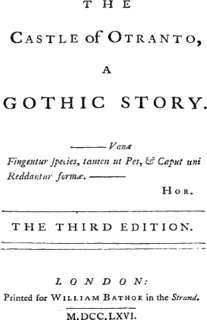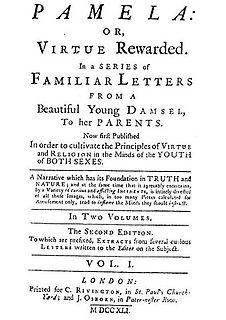
Gothic fiction, sometimes called Gothic horror in the 20th century, is a genre of literature and film that covers horror, death and at times romance. It is said to derive from the English author Horace Walpole's 1764 novel The Castle of Otranto, later subtitled "A Gothic Story". Early contributors included Clara Reeve, Ann Radcliffe, William Thomas Beckford and Matthew Lewis. It tends to stress emotion and a pleasurable terror that expands the Romantic literature of the time. The common "pleasures" were the sublime, which indescribably "takes us beyond ourselves." Such extreme Romanticism was popular throughout Europe, especially among English and German-language authors. Its 19th-century success peaked with Mary Shelley's Frankenstein and work by E. T. A. Hoffmann, Edgar Allan Poe and Charles Dickens, and in poetry with Samuel Taylor Coleridge. Also prominent was the later Dracula by Bram Stoker, Richard Marsh's The Beetle and Strange Case of Dr Jekyll and Mr Hyde by Robert Louis Stevenson. The name Gothic spread from the Goths to mean "German". It also draws in Gothic architecture of the European Middle Ages, where many of the stories occur. Twentieth-century contributors include Daphne du Maurier, Stephen King, Shirley Jackson, Anne Rice and Toni Morrison.

Jane Austen was an English novelist known primarily for her six major novels, which interpret, critique and comment upon the British landed gentry at the end of the 18th century. Austen's plots often explore the dependence of women on marriage in the pursuit of favourable social standing and economic security. Her works critique the novels of sensibility of the second half of the 18th century and are part of the transition to 19th-century literary realism. Her use of biting irony, along with her realism, humour, and social commentary, have long earned her acclaim among critics, scholars, and popular audiences alike.

Pride and Prejudice is an 1813 novel of manners written by Jane Austen. Though it is mostly called a romantic novel, it is also a satire. The novel follows the character development of Elizabeth Bennet, the dynamic protagonist of the book who learns about the repercussions of hasty judgments and comes to appreciate the difference between superficial goodness and actual goodness.

Sense and Sensibility is a novel by Jane Austen, published in 1811. It was published anonymously; By A Lady appears on the title page where the author's name might have been. It tells the story of the Dashwood sisters, Elinor and Marianne as they come of age. They have an older half-brother, John, and a younger sister, Margaret.
Historical fiction is a literary genre in which the plot takes place in a setting located in the past. Although the term is commonly used as a synonym for the historical romance, it can also be applied to other types of narrative, including theatre, opera, cinema, and television, as well as video games and graphic novels.

Ann Radcliffe was an English author and a pioneer of Gothic fiction. Her technique of explaining apparently supernatural elements in her novels has been credited with gaining Gothic fiction respectability in the 1790s. Radcliffe was the most popular writer of her day and almost universally admired; contemporary critics called her the mighty enchantress and the Shakespeare of romance-writers, and her popularity continued through the 19th century. Interest has revived in the early 21st century, with the publication of three biographies.

The English novel is an important part of English literature. This article mainly concerns novels, written in English, by novelists who were born or have spent a significant part of their lives in England, Scotland, Wales, or Northern Ireland. However, given the nature of the subject, this guideline has been applied with common sense, and reference is made to novels in other languages or novelists who are not primarily British, where appropriate.

A romance novel or romantic novel generally refers to a type of genre fiction novel which places its primary focus on the relationship and romantic love between two people, and usually has an "emotionally satisfying and optimistic ending." However, precursors include authors of literary fiction, such as Samuel Richardson, Jane Austen, and Charlotte Brontë.

Regency romances are a subgenre of romance novels set during the period of the British Regency (1811–1820) or early 19th century. Rather than simply being versions of contemporary romance stories transported to a historical setting, Regency romances are a distinct genre with their own plot and stylistic conventions. These derive not so much from the 19th-century contemporary works of Jane Austen, but rather from Georgette Heyer, who wrote over two dozen novels set in the Regency starting in 1935 until her death in 1974, and from the fiction genre known as the novel of manners. In particular, the more traditional Regencies feature a great deal of intelligent, fast-paced dialogue between the protagonists and very little explicit sex or discussion of sex.

As a literary genre of high culture, heroic romance or chivalric romance is a type of prose and verse narrative that was popular in the noble courts of High Medieval and Early Modern Europe. They were fantastic stories about marvel-filled adventures, often of a chivalric knight-errant portrayed as having heroic qualities, who goes on a quest. It developed further from the epics as time went on; in particular, "the emphasis on love and courtly manners distinguishes it from the chanson de geste and other kinds of epic, in which masculine military heroism predominates."
The Regency period in the United Kingdom is the period between 1811 and 1820, when King George III was deemed unfit to rule and his son, later George IV, was instated to be his proxy as Prince Regent. It was a decade of particular manners and fashions, and overlaps with the Napoleonic period in Europe.
The sentimental novel or the novel of sensibility is an 18th-century literary genre which celebrates the emotional and intellectual concepts of sentiment, sentimentalism, and sensibility. Sentimentalism, which is to be distinguished from sensibility, was a fashion in both poetry and prose fiction beginning in the eighteenth century in reaction to the rationalism of the Augustan Age.

Pamela; or, Virtue Rewarded is an epistolary novel first published in 1740 by English writer Samuel Richardson. Considered one of the first true English novels, it serves as Richardson's version of conduct literature about marriage. Pamela tells the story of a fifteen-year-old maidservant named Pamela Andrews, whose employer, Mr. B, a wealthy landowner, makes unwanted and inappropriate advances towards her after the death of his mother. Pamela strives to reconcile her strong religious training with her desire for the approval of her employer in a series of letters and, later in the novel, journal entries all addressed to her impoverished parents. After various unsuccessful attempts at seduction, a series of sexual assaults, and an extended period of kidnapping, the rakish Mr. B eventually reforms and makes Pamela a sincere proposal of marriage. In the novel's second part Pamela marries Mr. B and tries to acclimatise to her new position in upper-class society. The full title, Pamela; or, Virtue Rewarded, makes plain Richardson's moral purpose. A best-seller of its time, Pamela was widely read but was also criticised for its perceived licentiousness and disregard for class barriers. The action of the novel is told through letters and journal entries from Pamela to her parents.

Mary: A Fiction is the only complete novel by 18th-century British feminist Mary Wollstonecraft. It tells the tragic story of a female's successive "romantic friendships" with a woman and a man. Composed while Wollstonecraft was a governess in Ireland, the novel was published in 1788 shortly after her summary dismissal and her decision to embark on a writing career, a precarious and disreputable profession for women in 18th-century Britain.

The reception history of Jane Austen follows a path from modest fame to wild popularity. Jane Austen (1775–1817), the author of such works as Pride and Prejudice (1813) and Emma (1815), has become one of the best-known and most widely read novelists in the English language. Her novels are the subject of intense scholarly study and the centre of a diverse fan culture.

The author Jane Austen and her works have been represented in popular culture in a variety of forms.

A novel is a relatively long work of narrative fiction, typically written in prose and published as a book. The present English word for a long work of prose fiction derives from the Italian: novella for "new", "news", or "short story of something new", itself from the Latin: novella, a singular noun use of the neuter plural of novellus, diminutive of novus, meaning "new". Some novelists, including Nathaniel Hawthorne, Herman Melville, Ann Radcliffe, John Cowper Powys, preferred the term "romance" to describe their novels.

Jane Austen's (1775–1817) distinctive literary style relies on a combination of parody, burlesque, irony, free indirect speech and a degree of realism. She uses parody and burlesque for comic effect and to critique the portrayal of women in 18th-century sentimental and Gothic novels. Austen extends her critique by highlighting social hypocrisy through irony; she often creates an ironic tone through free indirect speech in which the thoughts and words of the characters mix with the voice of the narrator. The degree to which critics believe Austen's characters have psychological depth informs their views regarding her realism. While some scholars argue that Austen falls into a tradition of realism because of her finely executed portrayal of individual characters and her emphasis on "the everyday", others contend that her characters lack a depth of feeling compared with earlier works, and that this, combined with Austen's polemical tone, places her outside the realist tradition.

Ann Herendeen is an American author of popular fiction. Herendeen's novels are notable for their queering of the traditional Romance novel.

The type of romance considered here is mainly the genre of novel defined by the novelist Walter Scott as "a fictitious narrative in prose or verse; the interest of which turns upon marvellous and uncommon incidents", in contrast to mainstream novels which realistically depict the state of a society. These works frequently, but not exclusively, takes the form of the historical novel. Scott's novels are also frequently described as historical romances, and Northrop Frye suggested "the general principle that most 'historical novels' are romances". Scott describes romance as a "kindred term", and many European languages do not distinguish between romance and novel: "a novel is le roman, der Roman, il romanzo".















